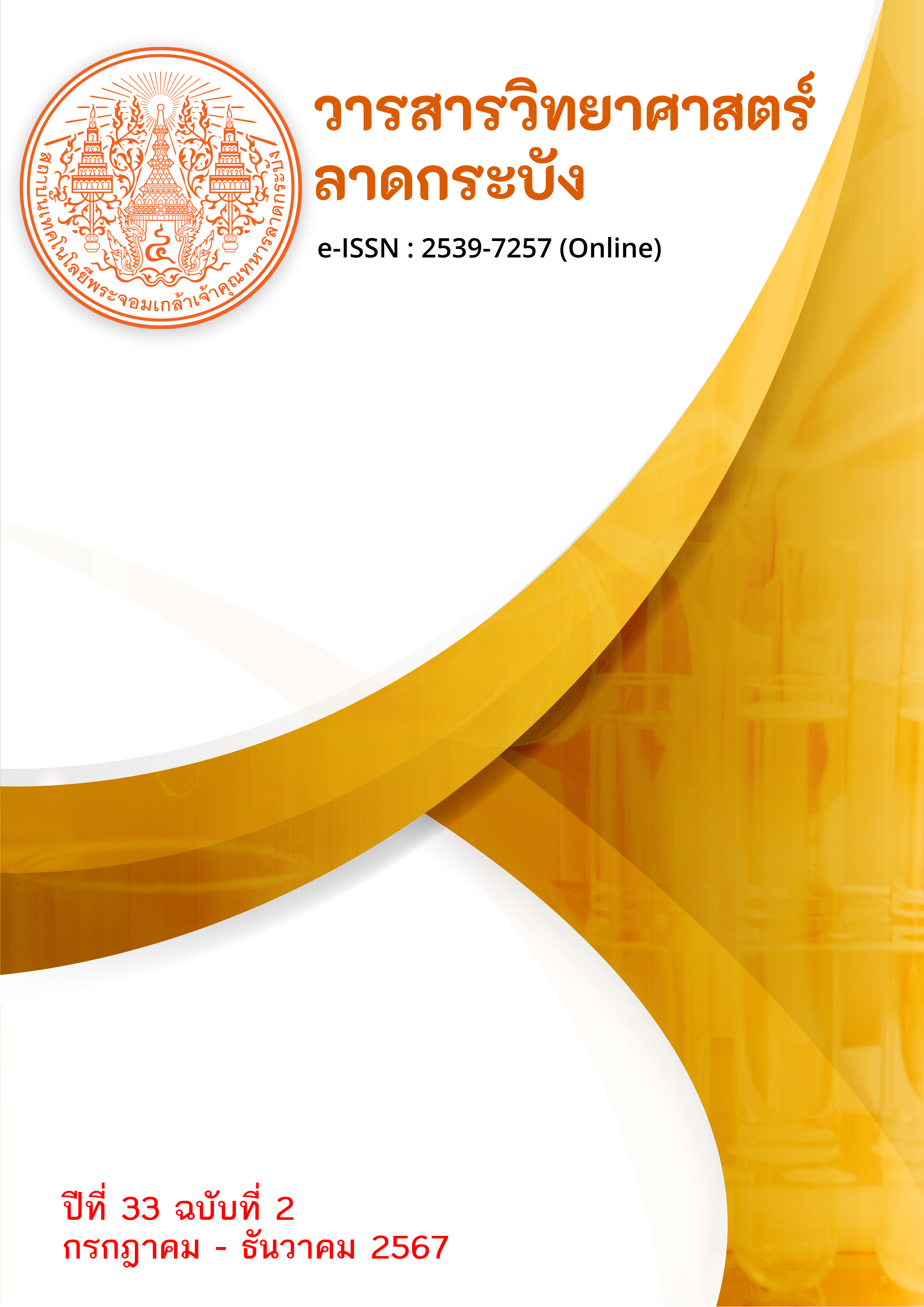การเปรียบเทียบสัมประสิทธิ์ความแม่นยำของการจำลองอัตราการไหลน้ำท่า
Main Article Content
บทคัดย่อ
ข้อมูลอัตราการไหลของน้ำเป็นข้อมูลที่สำคัญในโครงการพัฒนาแหล่งน้ำ การเก็บข้อมูลน้ำท่าระยะยาวเป็นเรื่องยาก เนื่องจากปัญหาด้านการบำรุงรักษาหรือปัญหาทางด้านเทคนิค การใช้แบบจำลองคณิตศาสตร์สามารถสร้างข้อมูลน้ำท่าที่ขาดหายไปได้ โดยข้อมูลจำลองเหล่านี้จำเป็นต้องทำการปรับเทียบและตรวจสอบความถูกต้องโดยใช้สัมประสิทธิ์ความแม่นยำ สัมประสิทธิ์ความแม่นยำที่แตกต่างกันสามารถใช้ในการประเมินผลลัพธ์การจำลองทางอุทกวิทยาได้ บทความนี้ได้นำเสนอความเหมาะสมและข้อจำกัดในการใช้งานสัมประสิทธิ์ความแม่นยำ เพื่อตรวจสอบข้อมูลน้ำท่าจำลองตามวัตถุประสงค์การใช้งาน 3 กรณี ได้แก่ กรณีสมดุลน้ำ กรณีน้ำหลาก และกรณีน้ำแล้ง ข้อมูลน้ำท่าจำลองที่ใช้ในการวิจัยสร้างขึ้นโดยให้มีความผิดพลาดแบบเป็นระบบ และความผิดพลาดแบบพลวัตร สัมประสิทธิ์ความแม่นยำ 21 ชนิดถูกเลือกภายใต้หลักการของค่าคลาดเคลื่อนสัมพัทธ์และค่าคลาดเคลื่อนสัมบูรณ์ในการตรวจสอบน้ำท่าจำลอง ผลการศึกษาพบว่าความผิดพลาดแบบเป็นระบบของทุกกรณีน้ำท่าจำลอง สามารถใช้ดัชนี NSE, NSEj=1, NSEj=3, NSErQ, ln NSE, NSEsqrtQ, NSEiQ, MSE, RMSE, MAE, RMSRE และ AAPE เพื่อตรวจสอบน้ำท่าจากแบบจำลองคณิตศาสตร์และสามารถหาแนวโน้มของความถูกต้องในการจำลองได้ นอกจากนี้ยังสามารถใช้สัมประสิทธิ์ความแม่นยำ RLFDoH เพื่อตรวจสอบผลการจำลองกรณีน้ำหลาก และสัมประสิทธิ์ความแม่นยำ NSEuL, BuL และ RLFDuL เพื่อตรวจสอบการจำลองกรณีน้ำแล้งได้อีกด้วย สำหรับความผิดพลาดแบบพลวัตรพบว่า สัมประสิทธิ์ความแม่นยำ NSEj=1, NSEiQ และ RMSRE มีความเหมาะสมเมื่อใช้กับกรณีจำลองสมดุลน้ำและน้ำหลาก สำหรับการจำลองน้ำท่ากรณีน้ำแล้งเหมาะสมกับสัมประสิทธิ์ความแม่นยำ NSEuL และ RLFDuL ผลการศึกษาสามารถใช้เป็นเกณฑ์อ้างอิงในการเลือกใช้งานสัมประสิทธิ์ความแม่นยำที่เหมาะสมต่อข้อมูลน้ำท่าจำลองได้เป็นอย่างดี
Article Details

This work is licensed under a Creative Commons Attribution-NonCommercial-NoDerivatives 4.0 International License.
References
Srivichai, M. 2016. The vulnerability of water resources management as a result of climate change in Chiang Rai province. Journal of Current Science and Technology, 6(2), 165-171.
Tal-maon, M., Broitman, D., Portman, M. E. and Housh, M. 2024. Combining a hydrological model with ecological planning for optimal placement of water-sensitive solutions. Journal of Hydrology, 628, 1-9, https://doi.org/10.1016/j.jhydrol.2023.130457.
Mehta, D. et al. 2023. Improving flood forecasting in Narmada river basin using hierarchical clustering and hydrological modelling. Results in Engineering, 20, 1-13, https://doi.org/10.1016/j.rineng.2023.101571.
Horta, A., Oliveira, A.R., Azevedo, L. and Ramos, T.B. 2023. Assessing the use of digital soil maps in hydrological modeling for soil-water budget simulations-implications for water management plans in southern Portugal. Geoderma Regional, 1-25, https://doi.org/10.1016/j.geodrs.2023.e00741.
Yu, S., Qin, H. and Ding, W. 2023. Modeling the effects of vegetation dynamics on the hydrological performance of a bioretention system. Journal of Hydrology, 620, 1-7, https://doi.org/10.1016/j.jhydrol.2023.129473.
Nash, J.E. and Sutcliffe, J.V. 1970. River flow forecasting through conceptual models part I—A discussion of principles. Journal of hydrology, 10(3), 282-290.
Krause, P., Boyle, D.P. and Bäse, F. 2005. Comparison of different efficiency criteria for hydrological model assessment. Advances in geosciences, 5, 89-97, https://doi.org/10.5194/adgeo-5-89-2005.
Jain, S.K. and Sudheer, K.P. 2008. Fitting of hydrologic models: a close look at the Nash–Sutcliffe index. Journal of hydrologic engineering, 13(10), 981-986, https://doi.org/10.1061/(ASCE)1084-0699(2008)13:10(981).
Perrin, C., Michel, C., and Andréassian, V. 2001. Does a large number of parameters enhance model performance? Comparative assessment of common catchment model structures on 429 catchments. Journal of hydrology, 242(3-4), 275-301, https://doi.org/10.1016/S0022-1694(00)00393-0.
Wright, S. 1921. Correlation and causation. Journal of Agricultural Research, 20, 557–585.
Moriasi, D.N. et al. 2007. Model evaluation guidelines for systematic quantification of accuracy in watershed simulations. Transactions of the ASABE, 50(3), 885-900.
Hogue, T.S. et al. 2000. A multistep automatic calibration scheme for river forecasting models. Journal of Hydrometeorology, 1(6), 524-542, https://doi.org/10.1175/1525-7541(2000)001<0524:AMACSF>2.0.CO;2.
Oudin, L. et al. 2006. Dynamic averaging of rainfall‐runoff model simulations from complementary model parameterizations. Water Resources Research, 42(7), 1-10, https://doi.org/10.1029/2005WR004636.
Le Moine, N. 2008. The surface watershed seen from underground: a way to improve the performance and realism of rainfall-runoff models. Ph.D. Thesis, Geosciences and Natural Resources, Pierre and Marie Curie University.
Pushpalatha, R., Perrin, C., Le Moine, N. and Andréassian, V. 2012. A review of efficiency criteria suitable for evaluating low-flow simulations. Journal of Hydrology, 420, 171-182, https://doi.org/10.1016/j.jhydrol.2011.11.055.
Willmott, C.J. 1984. On the evaluation of model performance in physical geography. Spatial statistics and models, 40, 443-460, https://doi.org/10.1007/978-94-017-3048-8_23.
Fiseha, B.M. et al. 2013. Hydrological analysis of the Upper Tiber River Basin, Central Italy: a watershed modelling approach. Hydrological processes, 27(16), 2339-2351, https://doi.org/10.1002/hyp.9234.
Hwang, S.H., Ham, D.H. and Kim, J.H. 2012. A new measure for assessing the efficiency of hydrological data-driven forecasting models. Hydrological sciences journal, 57(7), 1257-1274, https://doi.org/10.1080/02626667.2012.710335.
